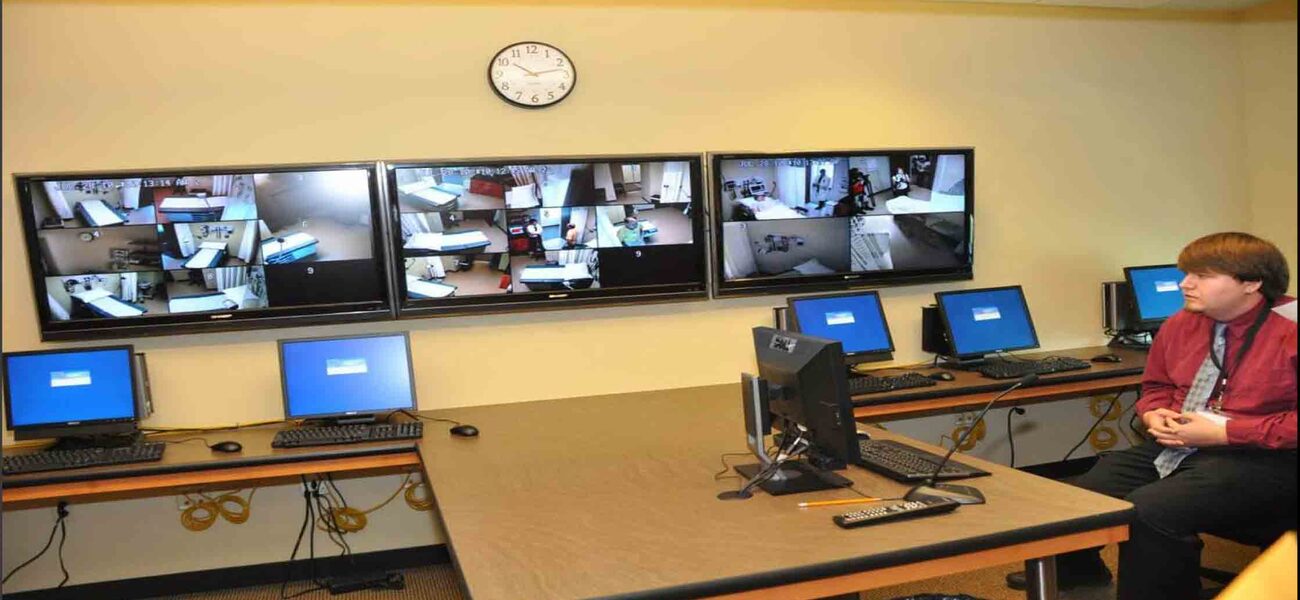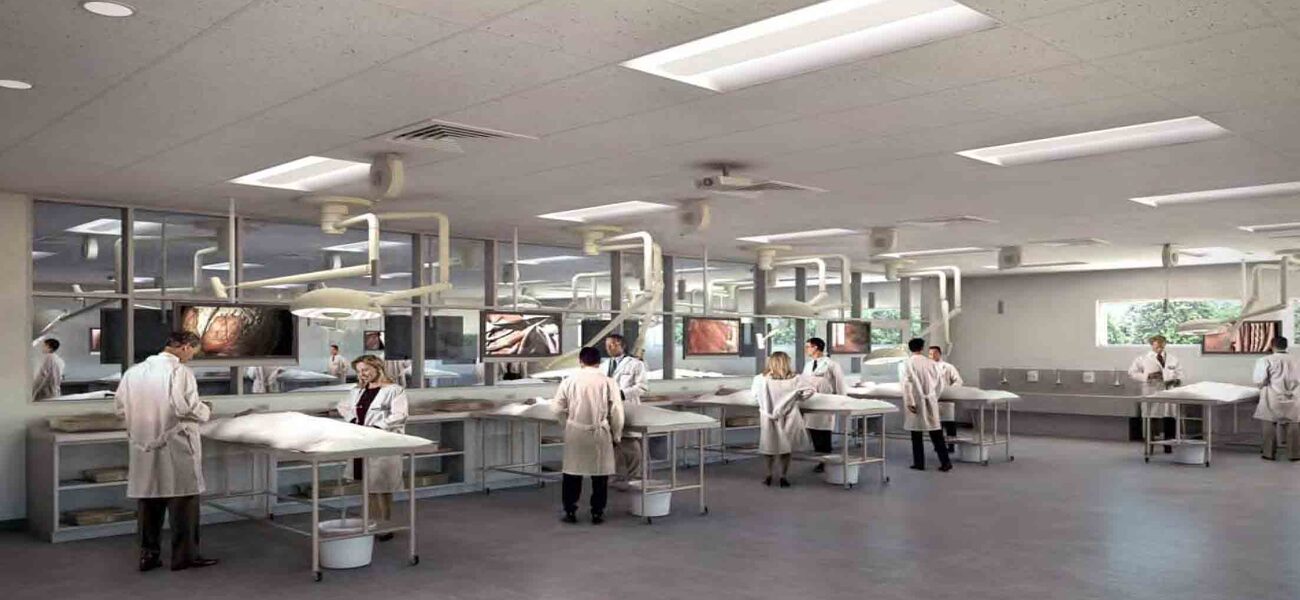The kind of technology becoming prevalent in today’s health sciences education requires a robust infrastructure that must be figured into a facility’s design during the budgeting and planning stages. Virtual simulation, virtual anatomy, tablet computers, 3-D stereographic display, software tools for collaboration, and touch interaction with LCD monitors—even the tried-and-true classroom technology, such as whiteboards, videoconferencing, telephone conferencing, dual-image large screen projection, large screen LCD monitors, and connectivity for personal devices—all require thoughtful consideration.
“Technology varies from one medical school to the next, but it is a significant part of the overall project cost,” says Nicholas Browse, president of Nicholas Browse & Associates. “Technology cannot be an afterthought in today’s teaching spaces. It’s hard to define the newest technology. Many existing technologies, such as the simulation mannequins, are constantly being upgraded, so you could consider them among the newest, even though they’ve been around for a while.”
Medical education facilities include many types of spaces, such as those used for clinical skills and simulation, and each requires specific technology.
Clinical Skills
Distinct spaces for clinical skills and simulation often complement each other, the primary difference being that clinical skills areas use standardized patients, or actors who pretend to have various medical conditions, and simulation uses mannequins or other task trainer devices.
The technology in a clinical skills exam room typically includes one or more cameras, microphones, telephones, loudspeakers, and an intercom. These tools allow recording of the encounters of students with standardized patients, and help instructors in an adjacent observation room communicate with students during these encounters.
“A ceiling-mounted camera allows it to be easily repositioned either as the room is turned over upon completion, or as the uses of the room change over time,” says Browse. “A pair of cameras, one looking at the exam table and the other at the interview table, is a good solution.”
Activities in the exam rooms and adjacent circulation areas are monitored in a control room, which essentially serves as a business management center for the clinical skills operation. The control room manages the clinical skills center by monitoring daily activities, supervising the movement of people, controlling recordings, and performing scheduling and other administrative tasks. Technicians monitor the action in each exam room and troubleshoot problems as they occur.
“Clinical skills centers with a large number of exam rooms need to manage the flow of people, including students and standardized patients, and to perform associated administrative tasks,” says Browse. “The control room will have several large video monitors, displaying views of all cameras in the facility, as well as communications devices for paging and announcements. There will also be several computers for administrative work.”
A faculty viewing room may be used by faculty to observe activity in the clinical skills center. The technology enables faculty members to watch in real time or to review the video footage later with students. The faculty viewing room at the Eastern Virginia Medical School, for example, features intercoms at each viewing station to give the instructor a direct line of communication with students in the skills room.
Simulation
Simulation rooms can be used to simulate general-purpose spaces or very complex clinical environments, such as a high-tech operating room. Simulation is used predominantly in post-graduate or interprofessional settings.
Simulation rooms are often considered as video and audio recording spaces, where a student’s interaction with a mannequin can be recorded and played back for instructional purposes. Simulation rooms must be equipped with several cameras, at least one microphone, a telephone, a loudspeaker, or a voice intercom system to facilitate communication between students and faculty. The strategic placement of cameras is imperative.
The use of mannequins requires specific utilities—compressed air, power, oxygen, suction, and nitrogen—adding to the purchase price, which alone can be as high as $65,000, not including training.
Some universities are exploring virtual 3-D simulation that immerses participants in a virtual environment that can simulate anything from a clinical setting to a battlefield scene or a crash site. While virtual simulation has been used in other disciplines, it is relatively new in the health sciences.
“We saw the first beta test at Eastern Virginia Medical School around 2012. It has not been fully embraced in the planning of new facilities, as it is still in experimental mode,” says Shirine Boulos Anderson, a principal at the Ellenzweig architectural design firm in Massachusetts. “The software for this type of simulation has a lot of potential, but is still in development. Different types of environments, such as disaster scenes, can be created with sound effects and real-time theatricals.”
A CAVE, or cave automatic virtual environment, is a space where 3-D images are projected onto the walls, floor, and/or ceiling. The users perceive themselves to be inside an artificial environment, which can be as realistic as a disaster scene or as artificial as the inside of a molecule. Costs depend on several factors, especially the number of surfaces and the required image resolution, and can range from $500,000 to $5 million. There are also significant operating costs for the environments, because of the space they require.
Other types of spaces in simulation centers include areas where task trainers, or models of various parts of the human body, are used to help students master specific medical skills.
“You want to build a flexible space for the evolving technology because there are a lot of new products on the market,” says Boulos Anderson. “You want to make sure the necessary infrastructure is in place.”
Technology and Infrastructure Requirements for Simulation
The infrastructure for a simulation center must facilitate extensive data communications, and contingencies must be made to ensure that operations continue during a power failure. Since the infrastructure requirements can be substantial, Browse recommends addressing the facility’s needs and the potential costs at the outset of a project rather than attempting a later retrofit.
The simulation control room, adjacent to the simulation room with an observation window, provides necessary support to all aspects of the simulation space. Technicians are responsible for operating the mannequin, recording the simulation, creating an auditory environment, maintaining communications, assessing the performance of students, and simply observing.
“Frequently, several simulation rooms are clustered around a shared control room,” notes Browse. “Required equipment includes video and audio monitors to manage the recording; camera controllers for positioning cameras; microphones and communications devices to communicate with participants in the simulation; and several computers to run the simulation and conduct real-time student assessment.”
Choosing the Best Software
Simulation center management software should be viewed as a tool that advances learning and not simply something that runs cameras and microphones. It should support real-time assessment of students and track how students progress with the required skills.
“The software should allow the development of learning scenarios that can be developed, re-used, and shared with like institutions. It should integrate well with the institution’s existing IT systems,” says Browse. “It requires a scheduling component for students, spaces, and mannequins, and must manage hundreds of hours of video recordings. It may need to manage standardized patients and handle their payroll, manage the supplies the center uses, and support instruction on electronic health records.”
“The software is complex and costly, and its integration must be carefully managed and realistically budgeted,” says Browse. “For scheduling reasons alone, early consideration of software is important.”
A primary responsibility of the software is management of the video recording process. Software vendors use different technical standards for recording. These standards, in turn, affect cabling to the various cameras and microphones, and dictate the space needed to accommodate the necessary equipment, all of which are construction considerations. Choosing the software early avoids the need to carry additional cabling and to oversize equipment rooms.
Traditional Anatomy Labs
Many anatomy labs, which require proper ventilation to remove formalin fumes, also feature technological innovations. Touchscreen video monitors are usually located at each table, along with a power supply, cameras, and special lighting over the tables. Images from one table can be projected to the entire group; instructors wear wireless microphones for voice amplification; and videoconferencing allows procedures to be viewed by a large group.
Moving away from traditional dissection in a lab by using virtual anatomy is being discussed at academic medical centers, but it is expensive and requires a lot of energy.
“The challenge for us is to find a solution in the anatomy labs of today that can accommodate the virtual anatomy that is going to come in five or 10 years,” says Michael Lauber, president of Ellenzweig. “It is probably going to be some kind of 3-D display that may be touch sensitive.”
Technology for Today’s Classrooms
There are generally three kinds of classrooms in a medical education facility: studio, large-format, and small-format.
In the studio classroom, students are grouped in clusters and learn from each other. Each student cluster has a viewing surface, and students work together on a common shared display. Students can send their image to other groups around the room. Technologies include whiteboards, single large-screen LCD monitors for each team, connectivity among laptops or portable devices, image annotation, and the ability for instructors to share content with all students.
The flexibility and interactivity of this classroom make it a popular model, but there are concerns about students bringing their own devices, such as cell phones, laptops, and tablets. The biggest challenge is to provide collaboration tools to support consumer-level wireless devices.
“Multiple students often want to display their work simultaneously and engage each other and the instructor in dialog. Achieving this securely and reliably is a significant challenge, both for accessing the content through the network and displaying that content,” notes Browse. “The industry is responding by developing hardware and software that permit it, but there are many competing approaches and no standards.”
In a large-format classroom, instruction is primarily delivered from an instructor to students. Technology includes dual-image projection requiring a wide teaching wall, document camera requiring a large teaching station, videoconferencing, microphones, telepresence, 3-D displays, and wireless data transmission.
Browse says wireless Ethernet is cost-effective and flexible, but there are disadvantages in a large teaching space. For example, an instructor may ask students to download a file simultaneously, which can slow down the wireless network. Wireless performance also is not uniform throughout a room.
Small-format, problem-based learning delivers instruction primarily by discussion between an instructor and a small group of students. Technologies include single display screens, whiteboards, smart boards, telephone conferencing, and laptop connectivity.
Emerging Technologies
“As we have seen with handheld devices that are touch enabled, we are starting to see large-scale displays that are touch enabled and gesture enabled,” says Boulos Anderson. “They are everywhere, and students expect them. They become a recruiting tool, but they are a big investment.”
Large-scale displays will permit telepresence, where an instructor’s life-size image can be projected from another location onto a screen in the front of a classroom.
Medical schools are also interested in the type of technology used at the Cleveland Art Museum, where a visitor can touch any of the displays by hand and view information on the art object. A handheld device can be placed on a stand, and information about the display can be swiped onto the device for review at a later time.
Other technology of the future includes the ability to equip displays with sensors enabling observers to simply gesture at the screen to turn pages or zoom in.
By Tracy Carbasho
This report is based on a presentation given by Boulos Anderson, Browse, and Lauber at Tradeline’s 2013 Academic and Medical Health Science Centers conference.

